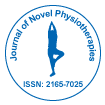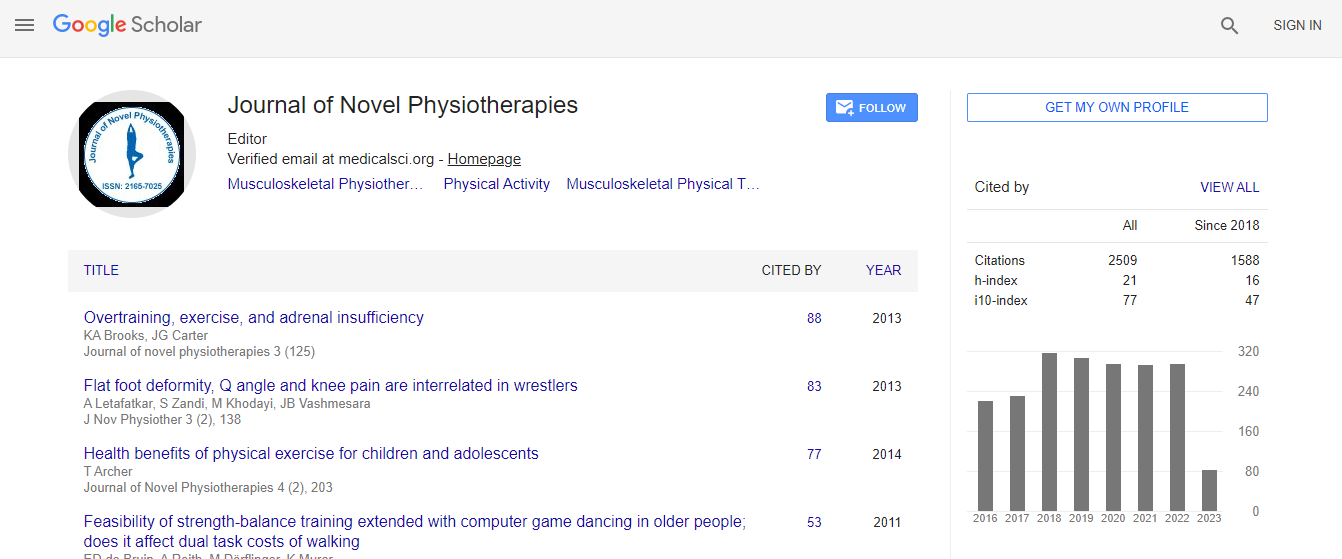Our Group organises 3000+ Global Conferenceseries Events every year across USA, Europe & Asia with support from 1000 more scientific Societies and Publishes 700+ Open Access Journals which contains over 50000 eminent personalities, reputed scientists as editorial board members.
Open Access Journals gaining more Readers and Citations
700 Journals and 15,000,000 Readers Each Journal is getting 25,000+ Readers
Google Scholar citation report
Citations : 3145
Journal of Novel Physiotherapies received 3145 citations as per Google Scholar report
Journal of Novel Physiotherapies peer review process verified at publons
Indexed In
- Index Copernicus
- Google Scholar
- Open J Gate
- Genamics JournalSeek
- Academic Keys
- SafetyLit
- RefSeek
- Hamdard University
- EBSCO A-Z
- OCLC- WorldCat
- Publons
- ICMJE
Useful Links
Recommended Journals
Related Subjects
Share This Page
Comparison of biofeedback training and manual training for correction of paradoxical breathing pattern
2nd International Conference and Expo on Novel Physiotherapies
Vandana Jaisingh
PHYWorld, India
ScientificTracks Abstracts: J Nov Physiother
Abstract
Introduction: The breathing pattern (BP) and rib cage-abdominal movement are relevant factors in understanding and assessing pulmonary impairment. Thoracoabdominal asynchrony/paradox��? refers to the asynchronous movement of the thorax and abdomen that can be seen with respiratory muscle dysfunction and increased work of breathing. This can be seen as a time lag/phase shift of thoracoabdominal motion or as pure paradox where the thorax and abdomen are moving in completely opposite directions at the same time. There are lot of recent studies showing the effect of breathing exercises and diaphragmatic breathing for improvement in paradoxical breathing pattern in obesity. The effect of electromyography (EMG) biofeedback to improve thoracoabdominal paradox has not been studied yet. Objective: To compare the two protocols and formulate a new treatment plan for correction of paradoxical breathing. Procedure: The subjects were assessed and divided into 2 groups group A and group B. All the subjects undergone an EMG assessment and cross sectional diameter at umbilicus level at the end of inspiration and expiration have been assessed. Group A received the biofeedback training to recruit the abdomen and manual training including diaphragmatic breathing with scooping for 20 sessions and again the diameter was assessed after end of every session and at the end of 10th and 20th session. EMG readings were assessed again. Group B received manual training including diaphragmatic scooping with diaphragmatic breathing to recruit the abdomen muscles for 20 sessions. And at the end of 10th and 20th session EMG assessment was done. At the end of 10th and 20th session the cross- sectional diameter was assessed and recorded. Results: For inter group analysis of results unpaired T-test was used and those results were considered who had a p-value of less than or equal to 0.05. The biofeedback training to correct paradoxical breathing [SDNN] = 4.5150 than control group [SDNN] = 2.7110 with p value<0.01 has been found to show significant results than manual diaphragmatic training. Conclusion: The biofeedback training can be an effective treatment for correcting the paradoxical breathing pattern in obese patients, but it can be more effective if patient is also under the weight loss programme. The diaphragmatic excursion will increase leading to significant change and patient can lead a better life without respiratory complications.Biography
Emídio Jorge Santos Lima is a MD, Master in Computer Modeling and PhD in Knowledge Diffusion. He has developed clinical studies, in the last 9 years, on weaning from mechanical ventilation. He is a Professor at University Salvador – Laureate International Universities Network and has published a book and some papers in reputed journals. Recently, he finished an international multicenter study on lung ultrasound score as one predictor of weaning from mechanical ventilation at the University of Paris – France.
Email: emidio.lima@gmail.com

 Spanish
Spanish  Chinese
Chinese  Russian
Russian  German
German  French
French  Japanese
Japanese  Portuguese
Portuguese  Hindi
Hindi 
